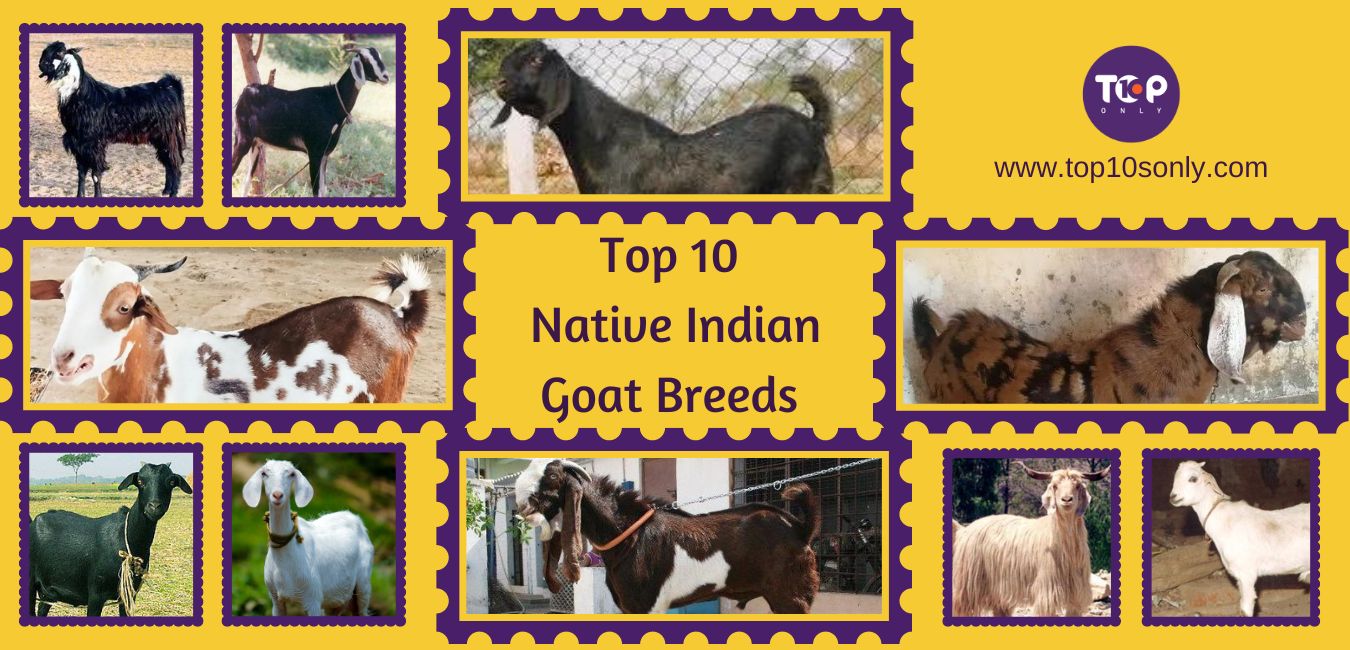Goat farming has been a traditional practice of livestock rearing in India, and it continues to be a significant source of livelihood and income for many farmers. Goats are primarily raised for their milk, meat, and manure, making it a profitable venture for small and marginal farmers due to low maintenance costs and high profits. In addition, it is a lucrative business option with substantial returns on investment, given the high demand for goat meat in India. As a result, commercial goat farms have increased, particularly in semi-urban areas, and are managed by entrepreneurs who invest in modern farming practices. This blog post by the Top 10s Only team will provide you with vital info regarding the Top 10 Native Indian Goat Breeds and their unique characteristics.
Discover The Traits Of The Top 10 Best Native Goat Breeds In India
Indigenous goat breeds in India are those that originated in the country and are highly popular throughout South Asia. These native breeds are renowned for their strength, resilience, and productivity, making them well-suited for a variety of climatic conditions. The list of top goat breeds in India includes several distinct breeds, each with their unique characteristics, traits, and performance. So read on to know more.
1. Jamunapari
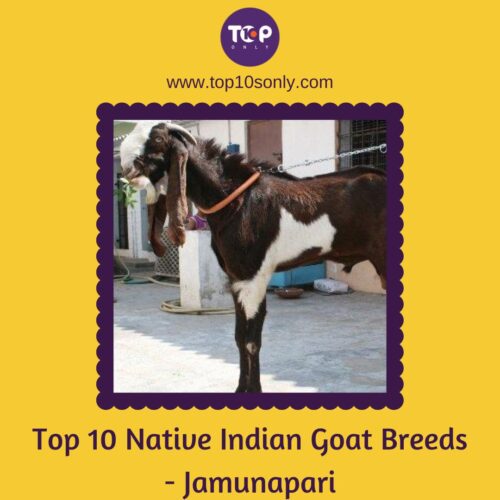
It is one of the most beautiful native Indian goat breeds in India. The name is derived from the river Jamuna in Uttar Pradesh. These are one of the top 10 goat breeds in India that are known for producing good milk as well as meat and are one of the most popular dairy goats. Due to this, these goats are being exported to countries like Indonesia and Bangladesh, where it has become a commercial success. Some of the features of this goat breed are as below:
This Native Indian Goat Breed Is Also Known As:
Ram Sagol, Jamnapari, Etawah, Chambal Queen
Physical traits
These are the most elegant and largest goats in India that have long legs. Typically they have a mouth that is of the shape of a parrot and a convex nose. They have ears that are dropping, flat and long. They have well-developed conical teats with a round-shaped udder. They have hair on the buttock and is called feathers.
Skin coat colour
They are white in colour and have a coat that is white with black or tan marks on the ears and neck.
Horns
Their horns are twisting backwards horizontally and are flat and short.
Climate Tolerance
They thrive in various conditions but need a lot of shrubs for browsing.
Place of Origin
They are mainly found in Uttar Pradesh
Body weight and height
An adult male weighs around 65 to 80 kg, and an adult female around 45 to 60 kg. They can go as tall as 80 cm in height.
Lifespan
On average, this native Indian goat breed can live for 15 to 18 years.
Milk Yield
280 kgs for 274 days a year. They can yield about 2.5 kg of milk every day making it one of the famous Indian goats reared for milk.
Fat Content
It ranges between 3 to 3.5%.
Lactation Duration
191 days.
Gestation Period
About 150 days. Kidding starts at about 2 years and can give birth to singlets or twins.
Purpose
These goats are not only well-suited for dairy production but also serve as valuable meat producers.
2. Malabari Goat
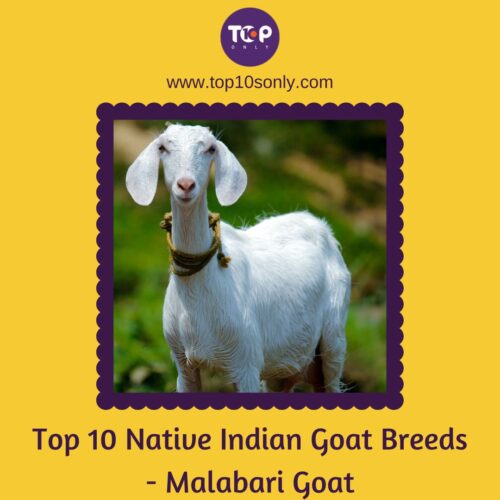
These are native Indian goat breeds that are medium in size and serve dual purposes, making them one of the Indian top 10 goat breeds. It is raised for meat but is also quite useful for their milk. These are among the most popular goats as they are fast-growing, good kidding and also yield high milk. The quality of the skin coat is very good and hence of great use in the tanning industry. Some of the characteristics of this goat are:
This Native Indian Goat Breed Is Also Known As:
Tellicherry, Malarbar, Cutch
Physical traits
These goats have medium-sized bodies, heads and ears. They have a ‘Roman nose’ with ears that are downward and outward. Both male and female goats have beards.
Skin coat colour
It can vary from black to white, and there is no uniform colour.
Horns
Their horns are slightly twisted and small. They are directed backwards and upwards, touching the skin.
Climate Tolerance
They do well in moderate conditions, one which is not too hot or cold.
Place of Origin
Native to the north of Kerala.
Body weight and height
The average weight of males is about 40 kg, and females are 31 kg. The average height is about 64 cm to 77 cm.
Lifespan
This native goat breed is believed to live for 7 years.
Milk Yield
The average milk yield is about 190 kg, with a milk yield of 1 to 2 kg per day.
Fat Content
It ranges between 2%.
Lactation Duration
178 days.
Gestation Period
145 to 156 days. They can start kidding in their 7th month and can give birth to singlets or twins.
Purpose
the Malabari Goat is typically eared for meat, and their skin is used in the tanning industry.
3. Beetal
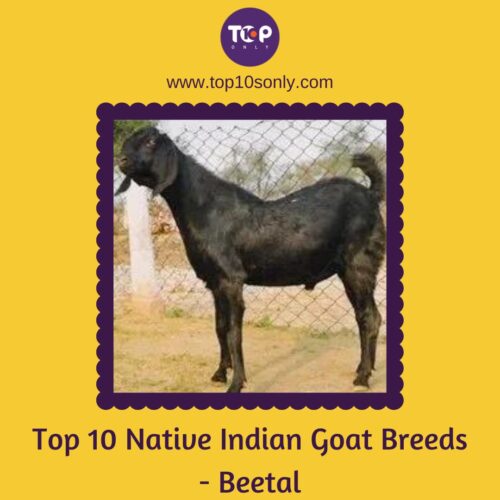
The Beetal goat is a native Indian goat breed that is beautiful but commonly found in many places. It has many distinct characteristics and is ideal for both milk and meat production. These are one of the native Indian goat breeds popular in India that look similar to Jamunapuri goat breeds. It is not only a famous breed in India but also in other Asian countries. Another advantage of these goats is that they can be raised on a farm with very little grazing place. Some of the other characteristics of this breed are:
This Native Indian Goat Breed Is Also Known As:
Lohori
Physical traits
These are goats that are bigger than other breeds but not compared to Jamnapari goats. They have well-developed but compact bodies. They have a Roman nose and a massive head with pendulous ears and long legs. They have short tails. Only males usually possess beards.
Skin coat colour
They have a coat colour that is brown, black or white spots.
Horns
Both female and male goats have spiralled horns that are curved backwards.
Climate Tolerance
They are hardy and adapt well to tropical climates and dry conditions. They can cope with extreme temperatures of 2ºC–42ºC
Place of Origin
They are a native of the Punjab and Haryana.
Body weight and height
An adult male weighs in the range of 50 to 70 kg, and the female about 40 to 50 kg.
Lifespan
This Indian goat breed can last 11 to 12 years.
Milk Yield
The milk yield is about 1 to 2 kg per day and the average lactation yield is 150 kg.
Fat Content
It ranges between 3 to 5%.
Lactation Duration
177 days.
Gestation Period
150 days. The first kidding can happen at 17 to 18 months
Purpose
They are reared for milk and commercial meat production.
4. Sirohi
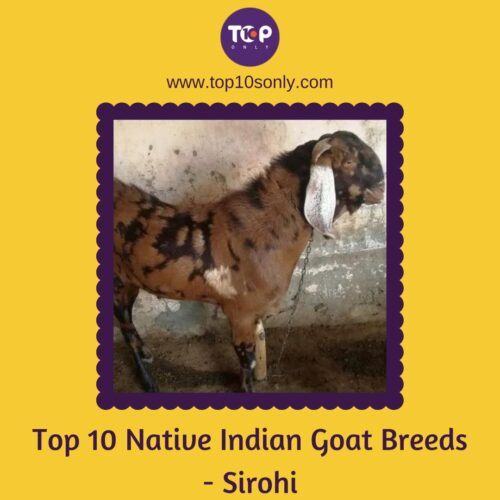
Sirohi is one of the top contenders on native Indian goat breed lists that is popular not only in Rajasthan and surrounding regions but also in many South Asian countries. This is a versatile and adaptable breed that is ideal for meat production. It is known as the meat goat breed due to its high meat content and is one of the best Indian goats for meat. It has great reproductive capacity, disease resistance and is hardy, making it a great option for those who want to rare goats. Here are the key characteristics of the Sirohi goat are:
This Native Indian Goat Breed Is Also Known As:
Ajmeri, Parbastar and Devgarhi
Physical traits
The Sirohi is a medium-sized goat with a body covered with coarse, soft and dense hair. They have flat medium-sized drooping ears. They have a tail that is upward, curved and medium in length. They have long and strong legs. The udder is round and small with lateral small teats.
Skin coat colour
The coat is mainly brown in colour and has light or dark brown patches. Some of the goats have completely white coats.
Horns
Both the male and female goats have curved small horns that are backward and upwards.
Climate Tolerance
Hot and arid conditions of Gujarat and Rajasthan
Place of Origin
Mainly found in Rajasthan.
Body weight and height
The average body weight of an adult male goat is 50 kg and an adult female is 23 kg.
Lifespan
This indigenous goat breed will live for 10 to 12 years, if taken care of properly.
Milk Yield
The average lactation yield is 71 kg per year and 1 to 2 kg per day
Fat Content
It ranges between 3 to 4%
Lactation Duration
175 days
Gestation Period
150 days. The first kidding can happen at 19 months. Twins are common and kidding can happen every year.
Purpose
Sirohi goats are raised for the purpose of producing milk and commercial meat.
5. Black Bengal
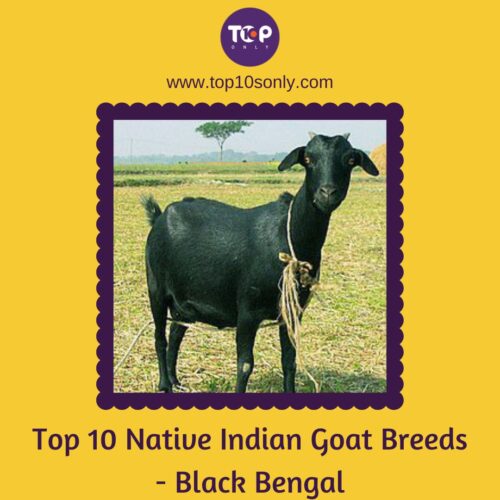
The Black Bengal is one of the most intriguing species of goats in India. While not much is known about genetics, the breed is a great source of income for the underprivileged farmers of Bengal. They have lean bodies and need less food and space to survive. They are most sought after for their high quality, tender and unique flavoured meat, making it a top-rated Indian goat breed for meat production. Plus, they feed on any fodder and have a high food-to-meat conversion. They can convert low-quality food to high-quality meat. More information on this breed is as below:
This Native Indian Goat Breed Is Also Known As:
NA
Physical traits
Black Bengal goats are mostly small or medium-sized but have short legs and a straight back. They have broad chest and a tight body that is shorter than other breeds. Both male and female goats have beards and their skin is smooth because of silky hair.
Skin coat colour
The coat is white, black, brown, grey or white. They have glossy, short and soft hair.
Horns
Both the male and female goats have small horns.
Climate Tolerance
They are natives of West Bengal and Bangladesh.
Place of Origin
Mainly found in Rajasthan.
Body weight and height
The average weight of an adult male is 15 kg, and an adult female is 12 kg.
Lifespan
The Black Bengal goat can survive for 8 to 10 years.
Milk Yield
The lactation yield is 53 kg and gives 1.5 kgs per day in the first month of lactation after which it drops drastically.
Fat Content
It is upto 4%
Lactation Duration
90 to 120 days
Gestation Period
148 days and the first kidding can happen in 9 to 10 months, with each kidding having 2, 3 or 4 kids at a time.
Purpose
This native goat breed is popular in India for its high-quality meat. The skin is in demand for high-quality shoes.
6. Barbari Goat
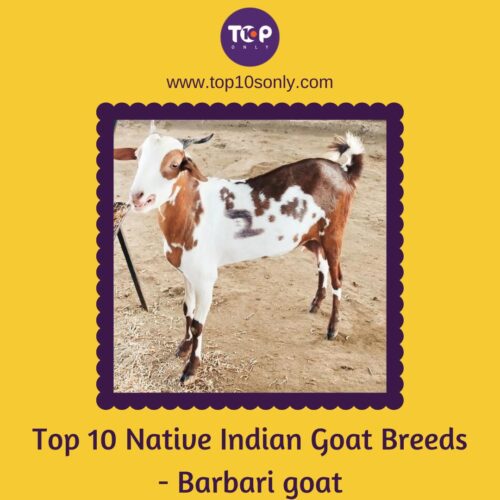
The Barbari goat is one of the best goat breeds in India that are beautiful to look at and has a compact body. They are attentive and alert and are commonly found in Pakistan too, apart from India. These goats are also exported to countries like Mauritius, Vietnam and Nepal and are ideal for a goat farming business. The features of this goat breed are:
This Native Indian Goat Breed Is Also Known As:
Wadi Bari, Bari, Titri Bari, Sai Bari, Thori Bari
Physical traits
These goats have compact body that is of medium size. They have unique characteristics like a predominant orbital bone. Their ears are tubular, short and have a slit in the front that is outward and upward. Male goats have thick beards. Female goats have conical teats and well-developed udder.
Skin coat colour
They are white in colour and have brown patches.
Horns
They have twisted horns that are of medium length and directed backwards and upward.
Climate Tolerance
They adapt well and can survive semi-arid conditions.
Place of Origin
Mainly found in Punjab, Gujarat, Agra, Haryana and Uttar Pradesh
Body weight and height
An adult male weighs between 35 to 45 kgs, and an adult female weighs 25 to 35 kgs.
Lifespan
The Barbari Goat’s lifespan is typically 15 to 18 years
Milk Yield
They can give 1.5 kg of milk every day during lactation and 107 kg per lactation.
Fat Content
It is upto 4%.
Lactation Duration
150 days.
Gestation Period
145 days. They kid twice in 12 to 15 months and give 2 to 3 kids and they kid for the first time at 15 months.
Purpose
They are meat goats and also good producers of milk
7. Kanni Adu
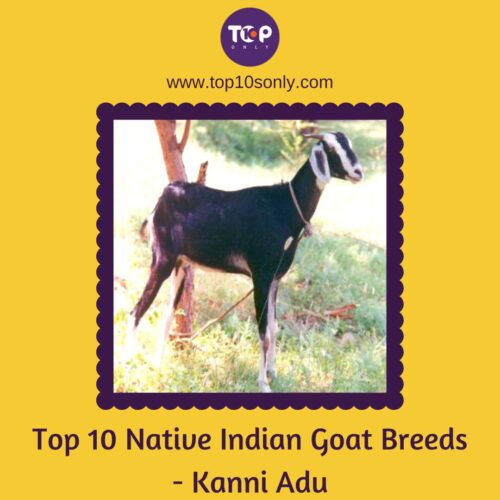
These are the tallest goats among the native Indian goat breeds. They have a high tolerance for heat and grow well even in places where there is drought. These are mainly meat goat breed and is one of the top 10 meat goat breeds that are not great milk producer. They have good kidding capacity and are known for their disease resistance and vigour.
This Native Indian Goat Breed Is Also Known As:
Pullaiadu and Karapuadu.
Physical traits
They are tall and large-sized goats. They have a straight face and pendulous long ears. They have a unique white strip on their face. They have a thin medium-sized tail that goes up. The udder is round and small, and the teats are conical and small.
Skin coat colour
They have a black coat with white or black spots in them.
Horns
Horns are curved outward and backwards. Females have polled horns, while males have strong horns.
Climate Tolerance
They are suited for hot and humid conditions.
Place of Origin
Ramanathapuram and Thirunelveli districts of Tamil Nadu.
Body weight and height
An adult male weighs around 35 to 40 kgs, and an adult female weighs about 25 to 30 kgs. The males can grow up to 81 cm tall.
Lifespan
NA.
Milk Yield
They are poor milkers.
Fat Content
It is upto 4%. They are poor milkers
Lactation Duration
They are poor milkers
Gestation Period
NA. The average kidding age start is 9 months.
Purpose
Their primary purpose is for meat production.
8. Kathiawari/Kutchi
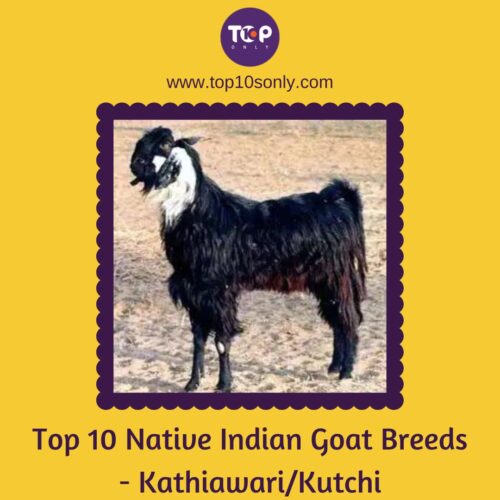
It is a goat breed that is commonly found in Gurjarat and is raised for both milk and meat production. These are also found in the nearby areas of Rajasthan, apart from Kutch. These breeds have good milk and meat and hence good goat breeds in India for milk and meat farming. Some of the characteristics of this breed are:
This Native Indian Goat Breed Is Also Known As:
Kathiawari
Physical Traits
They have medium-sized goats that have long legs and compact bodies. The ears of these goats are drooping, flappy and medium in size. They have white markings on the ears that are typical of this breed. They have a slight ‘Roman nose’, and their face is raised with coarse hair. The udder is well-developed and has conical teats.
Skin coat colour
They have a black coat with some white spots.
Horns
The male goats have strong and long horns, and the females have weak and flat horns.
Climate Tolerance
The Kathiawari/Kutchi goats can tolerate all types of climate.
Place of Origin
Kutch district of Gujarat.
Body weight and height
The male Kutchi goat weighs around 45 to 50 kg, and the female has an average weight of about 40 kg. They can grow as tall as 88 cm.
Lifespan
NA
Milk Yield
The average milk yield is 2 kg per day and 250 to 300 kg per lactation.
Fat Content
NA
Lactation Duration
6 to 7 months.
Gestation Period
148 days. The kidding age starts at 12 months.
Purpose
The Kathiawari/Kutchi goats are a dual-purpose goat breed that is reared for milk and meat production. These goats have good hair production.
9. Gaddi
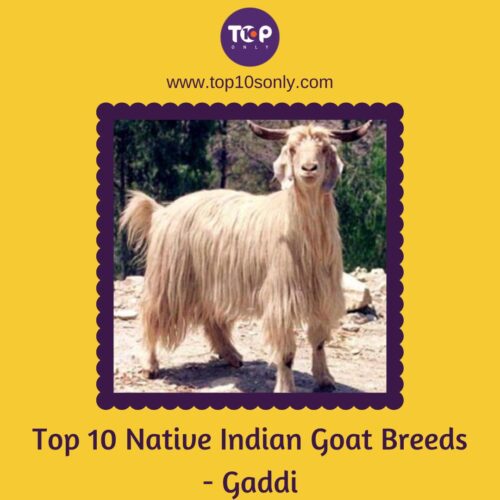
Gaddi is a native Indian goat breed that gets its name from the nomadic tribe that raises these goats. The goats are popular because of their valuable hair. These male goats are used as pack animals and also for goods transportation in the hilly regions. The other characteristics of this goat breed are:
This Native Indian Goat Breed Is Also Known As:
White Himalayan, Jamba. Kashmiri
Physical Traits
These goats are well-built and have long hair but are of medium size. They have a face with a small and convex nose. They have alert eyes, and their ears are drooping and long. The udder is small but well-developed and has conical teats.
Skin coat colour
They are predominantly white with tan, black or brown markings.
Horns
Both males and females are long and spiral with pointed tips that are backward and upward.
Climate Tolerance
They are well-adapted to the colder climates of the Himalayan ranges.
Place of Origin
They are found in the Chamoli, Dehradun, and Nainital districts of Uttarakhand, Chamba, Kullu, Kangra, Spiti and Bilaspur in Himachal Pradesh.
Body weight and height
An adult male weighs around 27 kgs, and an adult female around 35 kgs. The height of an adult male is about 61 cm, and that of a female is 58 cm.
Lifespan
12 to 13 years
Milk Yield
They are poor milkers.
Fat Content
NA
Lactation Duration
30 to 40 days.
Gestation Period
NA. The average kidding age is 350 days.
Purpose
Their hair is very valuable and is used for making ropes, rugs and other domestic utility items.
10. Surti
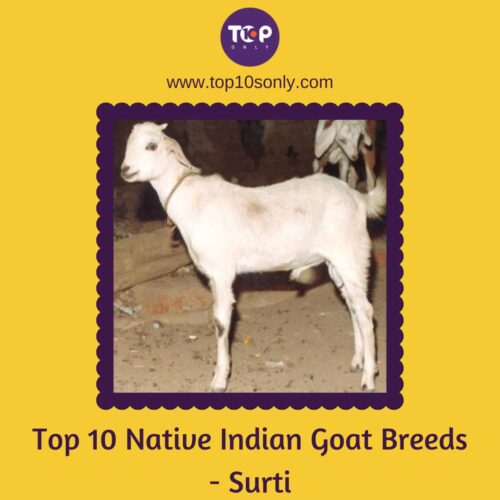
This is one of the important native Indian goat breeds. It is a goat that is reared mainly for milk production. There are one of the best goat breeds for milk in India but are also useful for meat production. These are a type of goat breeds in India that are economical to raise as they feed on food waste and leaves, but despite that, they are on the endangered goat’s list. Here are the characteristics of this breed:
This Native Indian Goat Breed Is Also Known As:
Surati
Physical Traits
These can be small to medium size and has a compact body. They have short white legs and cannot walk for a long duration. They have drooping ears, and the face is raised slightly. They have large conical teats with an udder that is well-developed.
Skin coat colour
They are mostly white in colour and have lustrous hair
Horns
Both males and females have horns that are medium in size and are directed backwards and upward.
Climate Tolerance
All types
Place of Origin
Surat, Maharashtra
Body weight and height
The average body weight of a male goat is 32 kg and that of a female is 30 kg.
Lifespan
NA
Milk Yield
They yield 2 to 2.25 kg of milk per day and 178 kg per lactation
Fat Content
3.2 to 4.2%
Lactation Duration
166 days
Gestation Period
NA. The age at first kidding is 400 to 450 days.
Purpose
They are used for milk and are ideal for meat production too. They are a great choice for commercial goat farming.
Conclusion
Goat rearing has long been the primary source of income and livelihood of farmers who are below the poverty line. However, in recent years goat farming, especially those that are native to India, has caught the imagination of others too because of its profitability. There are about 26 registered goat breeds in India, and the above are the Ten best goat breeds native to the Indian subcontinent that you too can try your hand at!
Make sure to checkout our article that lists the Top 10 Native Indian Cow Breeds.
Frequently Asked Questions About Native Indian Goat Breeds
1. Which breed of goats are found in India?
There are about 26 registered goat breeds in India some of which are Jamunapuri, Eetal, Barbari, Tellicheri, Osmanabadi, etc.
2. Which goat is best for milk?
The Jamunapuri is the best dairy goat in India.
3. Which is the best goat in India?
The Osmanabadi goats are among the best goats in India as they are ideal for milk production as well as for their meat.
4. Which breed of goat is tasty in India?
The Black Bengal goat has the tastiest meat in India.
5. Which goat breed is most profitable in India?
The Sirohi goat is one of the most profitable goat breeds in India.
.

